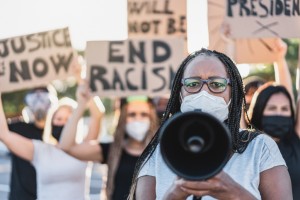Author SaraKay Smullens: Second Edition of Burnout and Self-Care in Social Work was desperately needed

Burnout and Self-Care in Social Work from NASW Press
Burnout and Self-Care in Social Work: A Guidebook for Students and those in Mental Health and Related Professions is one of the most popular books at NASW Press. Author SaraKay Smullens, talked to Social Workers Speak to explain what has happened in our society since the first edition was published, and why it was important to do a second edition.
Q: The first edition of your book “Burnout and Self-Care in Social Work” was a runaway hit when it was published by NASW Press more than seven years ago. What motivated you to write it, and why do you think it was as successful as it was?
 Smullens: I was alarmed — scratch that: horrified — by what surrounded me. I saw committed social workers leaving a profession they cared deeply about, ones they trained for arduously and devotedly. They told me they were leaving because they were “burned the hell out.”
Smullens: I was alarmed — scratch that: horrified — by what surrounded me. I saw committed social workers leaving a profession they cared deeply about, ones they trained for arduously and devotedly. They told me they were leaving because they were “burned the hell out.”
I had never heard the term burnout before, and for a fuller understanding began examining all of the research I could find, as well as conduct my own. I have always believed that understanding a problem well — its complexities and causation — can lead to addressing it as successfully as possible. My goal was to define precisely what burnout is, as well as address what could be done to alleviate and prevent it.
The success of the first edition surprised everyone, no one more than me. I have thought about the reasons. At the time of publication burnout was not a known concept or household word. This was despite the fact burnout had been identified in the mid 1970s by psychologist Herbert Freudenberger, with the intensive work of Christina Mashlach occurring in roughly the same period, as well as foreshadowed by futurists Heidi and Alvin Toffler in 1970. Also, what had been written was limited largely to a concentration on professional burnout,
My research clearly showed, however, that burnout was a far more complicated phenomenon than was described in the public lexicon. It exists in multiple arenas, each interacting and impacting on the other: These arenas are professional (a work setting’s organization, supervision, and peer interaction); personal (our psychological, emotional, cognitive, intellectual and religious/spiritual dimensions); relational (including one’s partner, immediate family, and circle of friends and acquaintances); and physical (the care of one’s own body and attention to its signals).
What also was missing in the literature was a clear understanding of burnout causation from a psych-social orientation (not limited to the obvious, such as a lack of sleep, exercise, and healthy eating). I sifted through voluminous studies, and with busy students and professionals in mind, narrowed causation to vicarious trauma.
Vicarious trauma includes taking on a client’s fear and terror; counter-transference — feelings aroused when caring for very difficult, ill mannered, and thoroughly draining people; and compassion fatigue, when one hits “emotional empty,” and experiences the realization that my well is dry and I have no more to give.
The first edition is the first book on burnout and self-care I know of that provides in-depth, evidence-based strategies, behaviors and attitudes that alleviate and prevent burnout specific to each noted arena. The result was not a one-size-fits-all approach, but one that is highly individualized – one that must be carefully and personally constructed and integrated in one’s life. Also, we surely were not the only profession experiencing the overload of burnout. I did my best, through clear explanation and case examples, to communicate in a way that those in other professions could find also find knowledge, insight and direction and transpose this information to their specific, diverse professions. The word-of-mouth success of this effort both amazed and humbled me.
Now you have put out a second edition of the book. What prompted you to write second edition?
The social and racial divisions rocking our country following the 2015 publication of the first edition, divisions intensified by dysfunctional societal leadership, the likes of which I had never seen or imagined, propelled me toward the second edition. The necessary research took hold of me to the extent that the book proposal submitted to NASW Press seemed as if it were writing itself.
I realized as I researched that it was essential to add a fifth burnout arena to those noted above — societal burnout, or a state of being in which we are overwhelmed, overburdened, and overloaded by a perfect storm of grave, threatening, unaddressed, long simmering societal problems. This state is often accompanied by a profound sense of mourning for what should be. Its existence, played out with overwhelming constancy 24/7 on social media, both leads to and intensifies the other arenas of burnout.
Putting findings together, I recognized the necessity of adding a fourth psycho-social cause of burnout. That is moral distress, a depleted state of being triggered by witnessing amoral acts, that may be born of malicious intent and tolerated or even provoked by professional and political leadership.
Further, I realized, as I spoke to students and colleagues, received feedback from presentations in this country and beyond (before the pandemic hit) and electronically once the pandemic arrived, that there was great confusion about the differences and similarities between burnout and depression, and the ways in which they may overlap.
I concluded that many among us believe they are depressed by the realities of today, and turn to medication that is hard to stop taking and may not be necessary, when they were actually burned out, and the self-care strategies offered could do a great deal to offer calm and coping skills. With this in mind, I felt it important to address these differences, as well as this overlap from a social work perspective.
In addition, students and newly minted social workers I met through webinars, presentations, and panel appearances asked for a richer, more complete understanding of inner world psychological development, and factors that encouraged and enhanced the capacities of children to rise above hardship and develop both survival and leadership skills in our ever turbulent, complex, extraordinarily fast paced, demanding society.
The world has changed a lot in several years. We are even more divided politically and economically; incidents of racism, including police murdering people of color have ignited massive protests and calls for reform; and of course we are still living in a pandemic. How have issues such as this affected social workers and their self-care?
What we now face in our society and with our clients often seems far too much to bear. We do our work realizing there are no safe havens, not even the schools and campuses of our young, not even faith communities and houses of worship.
Social work has been called an “impossible profession” for several reasons:
– We see endless pain and suffering, and the impact of grave inequities and prejudice.
– We must constantly examine all this touches in us, and it is a great deal.
– We are surrounded by those in powerful positions and their followers, who do not care about the well-being of society’s most vulnerable children and families, our clients.
– As a result, the necessary programs and resources to best assist our clients have always been highly inadequate.
 Today, however, the cost of what we face with our clients has grown in intensity, often seeming too hard to bear. Today, I allow tears to flow with my clients. This began after one died of COVID-19. Two other deaths followed. I no longer try to control the horror I see them face, and feel through our relationship.
Today, however, the cost of what we face with our clients has grown in intensity, often seeming too hard to bear. Today, I allow tears to flow with my clients. This began after one died of COVID-19. Two other deaths followed. I no longer try to control the horror I see them face, and feel through our relationship.
Today we are no longer merely burned out. To quote several colleagues, “We are beyond burnout. We are “F&%$%#ing Fried.” These words opened the keynote I was invited to offer at the fall 2021 meeting of the Society of Social Work Leadership in Health Care (SSWLHC), held in Tucson. The experiences of the front-line workers in hospitals and facilities throughout our country were reflective of all you we have heard, seen and known in the last several years.
These realities make the necessity of committed integration of individually selected self-care stratagems (those right for us!) — along with necessary attitudes and understanding to protect us — a grave necessity.
Part of this selection must include committing ourselves to working for and fighting for the adoption of the Social Determinants of Health – a “must” self and societal care priority.
As the late, great John Lewis stressed, we each must be involved in the “good trouble” that can save the soul of America.
What has been added to the second edition of the book and why should social workers read it?
 In addition to what is noted above, the edition is geared toward uplifting social work professionals. And offering what they asked me during webinars, presentations, and emails. Readers asked that more examples of journaling be woven throughout this edition. So I examined decades of personal journaling and found entries to begin each chapter. Readers also asked for a more extensive list of reflective questions following each chapter.
In addition to what is noted above, the edition is geared toward uplifting social work professionals. And offering what they asked me during webinars, presentations, and emails. Readers asked that more examples of journaling be woven throughout this edition. So I examined decades of personal journaling and found entries to begin each chapter. Readers also asked for a more extensive list of reflective questions following each chapter.
Also, at their request, the edition addresses reasons why our proud and historic profession is deeply misunderstood, suggests ways that this misguided reality can be addressed and changed, and stresses that at no time in our lifetimes have what social workers know and have been trained to offer been so desperately needed.
There is also a section demonstrating why changing the spelling of our profession to one word, SocialWork, could lead to more appropriate understanding, dispelling inaccurate perceptions. It was also important to highlight our commitments and what motivates us for non-social workers who may purchase the second edition.
The bottom line is that this edition is a love letter to our extraordinary, proud, and historic profession.
With everyone more isolated since the pandemic started, is it harder to practice self-care?
This question offers irony: I used to speak of the “I” in iPhone, iMac, I-this or I-that as symbolizing man’s latest isolation booth. Today it represents the opposite. We are social beings, and not being in close touch, able to share and touch each other is both painful and difficult. The second edition speaks of a patient during his exam who begins to cry, telling his physician that the touch of the examination is the first time he had been touched since his husband died.
It is essential to do all we can to compensate for this loss through the use of technology, supporting each other, being kind and patient with each other, and remaining in contact with those who live alone. I define self-care as a promise and gift to ourselves. It is imperative that we keep this promise, and claim this vital gift at every opportunity.
The first edition of your book offered advice on self-care. Based on how our society has changed since the first edition has your advice changed in any way? What hope and perspective does the second edition provide?
 My commitment to the necessity of self-care has intensified for each of the stated arenas (these strategies are carefully delineated in this edition), and my message demonstrates even more urgency.
My commitment to the necessity of self-care has intensified for each of the stated arenas (these strategies are carefully delineated in this edition), and my message demonstrates even more urgency.
Further, at a time when our democracy is threatened in ways that we never could have imagined, this edition stresses the interactive relationship between the personal, professional, and political — the need to understand how personal developmental opportunities impact on the health of families, on professions, and on all political entities and their decisions, which in turn impacts on what we provide for the individual throughout the life cycle.
Of these opportunities, none is more important or urgent than what we offer our children, What is clear is that our Constitution does not offer psychological protection from those for whom personal power and control over others overrides all else, or the appeal of autocratic cult leaders to those who believe their lies and see their cruelty and duplicity as strength.
The times are complex, surreal, and dangerous. We must care for ourselves, each other, our society, and face realities clearly, with focused goals. This edition marks the importance of an “emotional sense of direction” in achieving this.
Despite our grave concerns for the health and future of democracy, it is important to recognize that America is a young country. I see us in our adolescence, always a stormy period – one where we must decide if we have the courage to leave a self-centered childhood, become adults, and address challenges accordingly.
In America’s multicultural, multi-faith, bold and brave experiment in democracy, the grave, ugly realities of our unmet challenges mark a far cry from our stated Constitutional ideals.
However, despite leaders in families, work settings, communities, and society who work against the stated promise of a more perfect union – despite hard years we will face – the message of the second edition is that democracy will survive. With devoted self and societal care, our proud and historic profession will be essential in the promise of moving forward.
Extra: Listen to a conversation with SaraKay Smullens
About SaraKay Smullens
 Throughout her extensive social work career SaraKay Smullens, LCSW, ACSW, BCD, DCSW, CGP, CFLE, has never seen conflict or contradiction between the commitment to activism and devotion to innovative clinical practice. This dual involvement marks a professional life devoted to education, advocacy, and activism as essential forces to highlight and confront lethal patterns of behavior in relationships, work settings, and professional and societal avenues of power — as well as her determination to call attention to the knowledge and commitments of our proud and historic profession at every possible opportunity.
Throughout her extensive social work career SaraKay Smullens, LCSW, ACSW, BCD, DCSW, CGP, CFLE, has never seen conflict or contradiction between the commitment to activism and devotion to innovative clinical practice. This dual involvement marks a professional life devoted to education, advocacy, and activism as essential forces to highlight and confront lethal patterns of behavior in relationships, work settings, and professional and societal avenues of power — as well as her determination to call attention to the knowledge and commitments of our proud and historic profession at every possible opportunity.
SaraKay, a certified family life educator and group psychotherapist, whose private and pro-bono practice is Philadelphia based, is a recipient of both a Lifetime Achievement Award (2004) and Social Worker of the Year award (2018) from NASW-PA. She was recognized for her contributions to the literature; the codification of patterns of emotional abuse (always part of physical and sexual abuse, but meriting independent recognition), and a therapeutic model to address it; and her belief in the urgency of bringing social work awareness from our office settings to the general public.
SaraKay is the founder of the Philadelphia initiative, The Sabbath of Domestic Peace, which identified clergy as a “missing link” in addressing domestic violence, devoting itself to clergy involvement and education that prayer alone would not save lives and that couples in distress, due to abuse and violence, could not be seen together.
She has published in peer-reviewed journals, the popular press, and in myriad blogs, including Huffington Post, where her activist commentaries on the sexual abuse of women and children, her film and television reviews from a social work perspective, and her warnings about the threat of dangerous and dysfunctional leadership were highlighted.
SaraKay is the best-selling author of Whoever Said Life Is Fair?: A Guide to Growing Through Life’s Injustices and Setting Yourself Free: Breaking the Cycle of Emotional Abuse in Family, Friendships, Work, and Love. Her widely read article on burnout and self-care in The New Social Workers, “What I Wish I had Known,” won the 2013 NASW media award for best magazine article, and inspired the publication of Burnout and Self-Care in Social Work: A Guidebook for Students and those in Mental Health and Related Professions, first and second editions.
In 2019 SaraKay was one of five graduates of the University of Pennsylvania’s School of Policy and Practice inducted into its Inaugural Hall of Fame. Her professional papers and memorabilia are divided between the Archives of the University of Pennsylvania, a Special Collection in the library of Goucher College, and the John F. Kennedy Presidential Library.
| Leave A Comment

